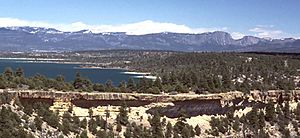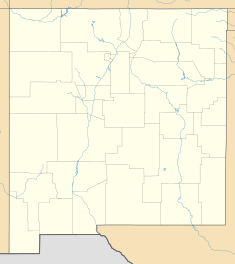Heron Dam facts for kids
Quick facts for kids Heron Dam |
|
|---|---|

The Brazos Cliffs, Heron Lake, and the north wall of the Rio Chama Gorge, looking east.
|
|
|
Location of Heron Dam in New Mexico
|
|
| Country | United States |
| Location | Rio Arriba County, New Mexico |
| Coordinates | 36°39′57″N 106°42′22″W / 36.665915°N 106.706226°W |
| Purpose | Irrigation |
| Opening date | 1971 |
| Owner(s) | United States Bureau of Reclamation |
| Dam and spillways | |
| Type of dam | Storage dam |
| Height | 263 feet (80 m) |
| Length | 1,250 feet (380 m) |
| Reservoir | |
| Total capacity | 401,000 acre-feet (495,000,000 m3) |
Heron Dam is a large storage dam located in northern New Mexico, in a place called Rio Arriba County. It's found in the southwestern United States, just north of another dam called El Vado Dam. The dam is owned and managed by the United States Bureau of Reclamation, which is a government agency that handles water resources.
You can find Heron Dam about 9 miles (about 14.5 kilometers) west of the small town of Tierra Amarilla.
Building Heron Dam
Heron Dam was built as part of a really big plan called the San Juan-Chama Project. This project helps move water from the San Juan River basin. The water travels through a long tunnel, 12.8 miles (20.6 km) (about 20.6 kilometers) long, called the Azotea Tunnel. This tunnel goes under the Continental Divide, which is like a giant mountain ridge that separates where rivers flow.
After passing through the tunnel, the water flows into Willow Creek. It is then stored in Heron Reservoir. This reservoir is an important part of the Colorado River Storage Project, which manages water in the Colorado River basin.
- The dam is located on Willow Creek, very close to where Willow Creek joins the Rio Chama.
- Building of the dam was finished in 1971.
- As part of the San Juan-Chama Project, the water release system at El Vado Dam, which is just downstream from Heron Dam, was made bigger. This was done so that water released from Heron Reservoir could easily pass through El Vado Dam without any problems. The El Vado outlet can now handle 6,600 cubic feet (190 m3) (about 187 cubic meters) of water per second.
How Heron Dam is Built
Heron Dam creates a large lake, or reservoir, that sits at an elevation of 7,192 feet (2,192 m) (about 2,192 meters) above sea level.
- The dam itself is made of earthfill, which means it's built from compacted soil and rock.
- It is 1,221 feet (372 m) (about 372 meters) long and 276 feet (84 m) (about 84 meters) high.
- About one mile (1.6 kilometers) northwest of the main dam, there's another structure called Heron Dike. This dike helps to hold the water in the reservoir.
- Heron Dike has a special concrete spillway, which is like a channel for water to flow over if the reservoir gets too full. This spillway can release 600 cubic feet (17 m3) (about 17 cubic meters) of water per second.
- The dam's main outlet system includes an intake structure (where water enters), a 10 feet (3.0 m) (about 3 meter) wide tunnel, a gate chamber to control water flow, and another tunnel that leads to a stilling basin (a pool that slows down the water).
- This outlet system can release 4,160 cubic feet (118 m3) (about 118 cubic meters) of water per second when the reservoir is at a certain level.
When the reservoir is completely full, it covers a huge area of 5,905 acres (23.90 km2) (about 23.9 square kilometers). The maximum amount of water it can safely hold is 401,000 acre-feet (495,000,000 m3) (about 494.6 million cubic meters). The river channel downstream from the dam can handle about 6,000 cubic feet (170 m3) (about 170 cubic meters) of water per second.
How Heron Dam Works
Heron Dam was built for a very specific purpose: to store and deliver water from the San Juan-Chama Project. This water is used for many important things, like:
- Providing water for cities and homes (municipal and domestic use).
- Supplying water for industries.
- Creating opportunities for fun activities like boating and fishing (recreation).
- Helping farmers water their crops (irrigation).
- Supporting fish and wildlife habitats.
The amount of water sent to New Mexico each year is carefully decided by agreements like the Colorado River and Upper Colorado River Compacts. These agreements make sure that water is shared fairly among different states.
- Water that naturally flows into Willow Creek and the Rio Chama upstream of the dam is measured. This "native" water is allowed to pass through the reservoir without being stored as part of the project water.
- Heron Dam also provides up to 5,000 acre-feet (6,200,000 m3) (about 6.2 million cubic meters) of San Juan-Chama water each year. This water helps keep the recreation pool full at Cochiti Reservoir, which is another popular spot for outdoor activities.
- The dam can reliably supply about 96,200 acre-feet (118,700,000 m3) (about 118.6 million cubic meters) of San Juan-Chama water annually to users.
- There's a rule that water users, like the City of Albuquerque or the Middle Rio Grande Conservancy District, must take their water by December 31st each year. They can't "carry over" unused water to the next year.
- Because of this rule, these users often take their water and arrange to store it in other dams downstream. Some of these dams include El Vado, Abiquiu, Jemez Canyon (through a special exchange), and Elephant Butte.
Citations
Sources


